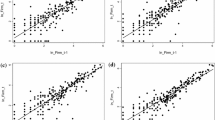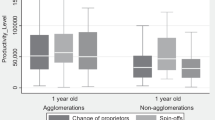Abstract
This study examines differences in the effects of start-up rates on subsequent employment change. Two sources of such differences—types of start-ups and types of regions—are analyzed. We find that differences between knowledge-based and other start-ups dominate differences between highly agglomerated and modestly agglomerated regions. In particular, differences in the effects of new start-ups on subsequent employment growth between highly agglomerated and modestly agglomerated regions are greater for knowledge-based start-ups than for other types of start-ups. The results suggest that, while knowledge-based start-ups are likely to impart greater benefits on future employment than other types of start-ups, these benefits are greater when those start-ups locate in more agglomerated regions.






Similar content being viewed by others
Notes
Economic activities in different regions differ accordingly to their composition in terms of sectors; therefore, regions with greater proportions of firms in declining sectors should display lower impacts of new firm formation on employment growth than regions with a greater proportion of firms in growing sectors. A shift-share procedure was used to correct for this kind of difference in, for instance, the studies by Baptista et al. (2008); and Mueller et al. (2008). Differences across regions in the effects of new firm formation on employment growth remained significant.
According to Acs and Mueller (2008), 40% of all the rapidly growing firms are located in only 20 metropolitan regions, which are mostly the largest cities in the United States.
Glaeser et al. (1992) find a positive correlation between agglomeration externalities and firm growth levels.
Hoetker and Agarwal (2007) find that significant diffusion of knowledge may occur after an innovative firm exits an industry if other firms are able to use that firm’s activities as a template to successfully replicate and extend its innovative knowledge.
Baptista and Preto (2009) seek to examine the effects on employment growth of start-up rates according to different types of entrants (e.g. small vs. large start-ups and domestics vs. foreign start-ups).
Disney et al. (2003) find that in the UK between 1980 and 1992 about half of productivity gain was because of internal factors, such as introducing new technology and organisational changes. The remaining half was because of external factors, most notably that the entrants were more productive than those exiting. However amongst single plant independent firms almost all the gains were attributable to external factors.
This classification includes high technology and medium–high technology industries, post and communications, finance and insurance and business services (OECD 2002).
The database is property of the Portuguese government and can be accessed on-site at the Observatory of the Ministry of Labor and Social Solidarity.
Tables containing the correlations of new firm entry over time are omitted due to space limitations, but are available from the authors upon request.
The estimation results and corresponding figures for FGLS are omitted due to space constraints but can be made available by the authors upon request.
The relative importance of incumbents and start-ups varies systematically across both regions and industries. For example, start-up rates are systematically higher in services than in manufacturing. Entrepreneurial activity could be systematically overestimated in regions with a high share of industries where start-ups play an important role, while the role of new firm formation in regions with a high share of industries where start-ups are relatively few would be underestimated. Following previous studies—pointed out in Section 1—in order to account for differences in regional industrial structures, and in the relative importance of start-ups and incumbents across industries a shift-share procedure (Ashcroft et al. 1991; Audretsch and Fritsch 2002) is applied in order to derive a measure of sector-adjusted start-up activity. The shift-share measure adjusts the raw data by imposing the same industry composition in each region (See Baptista et al. 2008 for a detailed explanation). Thus, the sector-adjusted number of start-ups is defined as the number of new firms in a region that can be expected to be observed if the composition of industries was identical across all regions.
Estimations showed spatial autocorrelation to be insignificant, therefore not affecting the coefficients for the other variables. To correct for this, following Fritsch and Mueller (2004), we compute for each region the average of the residuals in the neighbouring regions and include this variable as an explanatory variable in the model.
An appropriate way to do this is to use Likelihood Ratio tests. Comparing the Nth order Almon polynomial model with the (N + 1)th order Almon polynomial model comes down to a Likelihood Ratio test with one restriction, since each additional order of the polynomial adds one restriction to the model. In the present case, we find that the 4th order polynomial provides the best fit for the lag structure of the effects of new firm formation on regional employment change in each of the cases under analysis, so we present the estimation results for that model.
References
Acs, Z. J., Audretsch, D. B., Braunerhjelm, P., & Carlsson, B. (2004). The missing link: The knowledge filter and entrepreneurship in endogenous growth. CEPR Discussion Papers 4783, Centre for Economic and Policy Research, London.
Acs, Z. J., & Mueller, P. (2008). Employment effects of business dynamics: Mice, Gazelles and Elephants. Small Business Economics, 30, 85–100.
Aghion, P., Blundell, R., Griffith, R., Howitt, P., & Prantl, S. (2004). Entry and productivity growth: Evidence from microlevel panel data. Journal of the European Economic Association, 2, 265–276.
Anselin, L. (1988). Spatial econometrics: Methods and models. Dordrecht: Kluwer.
Anselin, L., & Florax, R. (1995). New directions in spatial econometrics: Introduction. In L. Anselin & R. Florax (Eds.), New directions in spatial econometrics (pp. 3–18). Berlin: Springer.
Arauzo-Carod, J.-M., Liviano-Solis, D., & Martin-Bofarull, M. (2008). New business formation and employment growth: Some evidence for the Spanish manufacturing industry. Small Business Economics, 30, 73–84.
Ashcroft, B., Love, J., & Malloy, E. (1991). New firm formation in the British counties with special reference to Scotland. Regional Studies, 25, 395–409.
Audretsch, D. B. (2003). Innovation and spatial externalities. International Regional Science Review, 26, 167–174.
Audretsch, D. B., & Fritsch, M. (1994). On the measurement of entry rates. Empirica, 21, 105–113.
Audretsch, D. B., & Fritsch, M. (2002). Growth regimes over time and space. Regional Studies, 36, 113–124.
Audretsch, D. B., & Thurik, A. R. (2004). The model of the entrepreneurial economy. International Journal of Entrepreneurship Education, 2, 143–166.
Baptista, R. (1998). Industrial clusters and the geography of innovation and production: A survey of the literature. In P. Swann, M. Prevezer, & D. Stout (Eds.), The dynamics of industrial clustering (pp. 106–123). London: Oxford University Press.
Baptista, R. (2000). Do innovations diffuse faster within geographical clusters? International Journal of Industrial Organization, 18, 515–535.
Baptista, R., Escária, V., & Madruga, P. (2008). Entrepreneurship, regional development and job creation: The case of Portugal. Small Business Economics, 30, 49–58.
Baptista, R., & Mendonça, J. (2009). Proximity to knowledge sources and the location of knowledge based start-ups. Annals of Regional Science. doi: 10.1007/s00168-009-0289-4.
Baptista, R., & Preto, M. T. (2009). Long term effects of new firm formation by type of start-up. Paper presented at the IECER 2009—Interdisciplinary European Conference on Entrepreneurship Research, March 2009, Lisbon, Portugal.
Beck, N., & Katz, J. N. (1995). What to do (and not to do) with time-series cross-section data. American Political Science Review, 89, 634–647.
Beesley, M. E., & Hamilton, M. T. (1984). Small firms’ seedbed role and the concept of turbulence. Journal of Industrial Economics, 33, 217–231.
Birch, D. L. (1981). Who creates jobs? The Public Interest, 65, 3–14.
Blien, U., Südekum, J., & Wolf, K. (2006). Local employment growth in West Germany: A dynamic panel approach. Labour Economics, 13, 445–458.
Disney, R., Haskel, J., & Heden, Y. (2003). Entry, exit and establishment survival in UK manufacturing. Journal of Industrial Economics, 51, 91–112.
Feldman, M. P. (1994). The geography of innovation. Dordrecht: Kluwer.
Fritsch, M., Brixy, U., & Falck, O. (2006). The effect of industry, region and time on new business survival—A multi-dimensional analysis. Review of Industrial Organization, 28, 285–306.
Fritsch, M., & Falck, O. (2007). New business formation by industry over space and time: A multi-dimensional analysis. Regional Studies, 41, 157–172.
Fritsch, M., & Mueller, P. (2004). The effects of new business formation on regional development over time. Regional Studies, 38, 961–975.
Fritsch, M., & Mueller, P. (2008). The effect of new business formation on regional development over time: The case of Germany. Small Business Economics, 30, 15–29.
Fritsch, M., & Noseleit, F. (2009). Investigating the anatomy of the employment effects of new business formation. Jena Economic Research Papers in Economics 2009–2001, Friedrich-Schiller-University Jena and Max-Planck-Institute of Economics.
Garofoli, G. (1994). New firm formation and regional development: The case of Italy. Regional Studies, 28, 381–393.
Geroski, P. A. (1995). What do we know about entry? International Journal of Industrial Organization, 13, 421–440.
Glaeser, E. L., Kallal, H. D., Scheinkman, J. A., & Shleifer, A. (1992). Growth in cities. Journal of Political Economy, 100, 1126–1152.
Henrekson, M., & Johansson, D. (2009). Gazelles as job creators—A survey and interpretation of the evidence. Small Business Economics. doi:10.1007/s11187-009-9172-z.
Hoetker, G., & Agarwal, R. (2007). Death hurts, but it isn’t fatal: The post-exit diffusion of knowledge created by innovative companies. Academy of Management Journal, 50, 446–467.
Jaffe, A., Trajtenberg, M., & Henderson, R. (1993). Geographic localization of knowledge spillovers as evidenced by patent citations. Quarterly Journal of Economics, 108, 577–598.
Mueller, P., van Stel, A. J., & Storey, D. J. (2008). The effects of new firm formation on regional development over time: The case of Great Britain. Small Business Economics, 30, 59–71.
OECD. (2002). OECD science, technology and industrial outlook. Paris: OECD.
Parks, R. W. (1967). Efficient estimation of a system of regression equation when disturbances are both serially and contemporaneously correlated. Journal of the American Statistical Association, 62, 500–509.
Romer, P. M. (1986). Increasing returns and long-run growth. Journal of Political Economy, 94, 1002–1037.
Romer, P. M. (1990). Endogenous technological change. Journal of Political Economy, 98, S71–S102.
Shane, S. (1996). Explaining variation in rates of entrepreneurship in the United States: 1899–1988. Journal of Management, 22, 747–781.
Trivedi, P. K. (1978). Estimation of a distributed lag model under quadratic loss. Econometrica, 46, 1181–1183.
van Praag, M., & Versloot, P. (2007). What is the value of entrepreneurship? A review of recent research. Small Business Economics, 29, 351–382.
van Stel, A. J., & Storey, D. J. (2004). The link between firm births and job creation: Is there an Upas tree effect. Regional Studies, 38, 893–909.
van Stel, A. J., & Suddle, K. (2008). The impact of new firm formation on regional development in the Netherlands. Small Business Economics, 30, 31–47.
Acknowledgements
The authors would like to thank Marcus Dejardin, Michael Fritsch, Pamela Mueller, Andre van Stel, and participants in the Special Session “Entrepreneurship and the Region” of 2007 ERSA Conference at ESSEC Business School (Paris). We are indebted to the Portuguese Ministry of Labor and Social Solidarity and to the Portuguese National Statistics Office (INE) for allowing us access to the data used in this paper. Miguel Torres Preto gratefully acknowledges the financial support of the Portuguese Foundation for Science and Technology (FCT grant SFRH/BD/22648/2005).
Author information
Authors and Affiliations
Corresponding author
Rights and permissions
About this article
Cite this article
Baptista, R., Preto, M.T. New firm formation and employment growth: regional and business dynamics. Small Bus Econ 36, 419–442 (2011). https://doi.org/10.1007/s11187-009-9254-y
Accepted:
Published:
Issue Date:
DOI: https://doi.org/10.1007/s11187-009-9254-y





